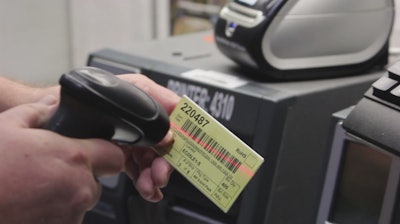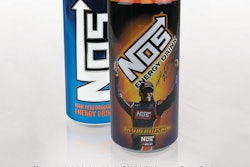Hypertherm Inc. is a global manufacturer of advanced plasma, laser and waterjet cutting systems, with its products used for cutting any type of metal in applications for a variety of industries including shipbuilding, manufacturing, and automotive repair. Its client list includes Ford, Volvo, Harley Davidson, and Caterpillar.
With operations and partners worldwide, Hypertherm was experiencing significant growth, yet its existing consumables product label printing system was not accommodating this growth, and was presenting considerable risks to the company’s operations in a lean manufacturing environment. The company’s “home-grown” labeling system was complex and customized with layers of third-party applications, posing connectivity issues for suppliers, and representing a single point of production failure.
Additional software licenses were no longer available to enable Hypertherm to grow or upgrade its existing deployment, and there were inherent issues with mislabeling. The system was also prone to breaking, ultimately causing significant downtime issues, representing a loss of productivity, with five to 10 hours of troubleshooting and fixing the label system each week. All of this resulted in customer dissatisfaction, brand integrity issues, and lost revenues, equaling $25,000 to $100,000 worth of productivity each week due to labeling issues.
Legacy system difficulties
Additionally, there were a variety of connectivity issues, which caused synching errors when trying to replicate data to local stations, which also resulted in more downtime.
Inability to print represented a critical issue, because when Hypertherm’s labeling process stopped, production stopped, and it was unable to get product out the door. Unfortunately, due to complexity of the legacy labeling system, it would take excessive amounts of time to figure out where the problem resided and get the system back up and running. This resulted in orders being delayed and lost credibility.
The existing system required a reliable network connection because it was synching information from an FTP server to a local database that resided on each workstation. If a failure occurred, there was no notification to the user and the labeling process continued, producing labels with incorrect data. Mislabeling or printing with the wrong data resulted in missed delivery deadlines, customers receiving incorrect parts, and costly returns. Incorrect labels had a downstream impact on customers, which could ultimately cause brand credibility issues and dissatisfaction.
And when a user selected a wrong printer and the job went to print, Hypertherm would need to start the print process over. Hypertherm realized that it needed to establish a good technology foundation to eliminate, or at least reduce the role of human error in the occurrence of mislabeling.
The company wanted to simplify its labeling approach so that it could configure a single enterprise application. Hypertherm sought an automated approach that would allow it to simply scan a part number so that it would automatically pick the appropriate label template, the printer and the media, rather than requiring manual entry, which added more failure points. It also wanted a “poke-yoke”-compliant system, meaning that workers could simply scan a tray to establish the appropriate part number rather than manually typing in part numbers to avoid mislabeling.
Single-person responsibility
Hypertherm’s custom labeling application was primarily developed and managed by one manufacturing person, who represented a single point of knowledge and failure for this complex, multi-layered printing system. Hypertherm recognized the risk and inefficiency of having a single resource responsible for its labeling.
Maintaining its 42 printer stations was a daunting task. Setting up each label station entailed a complex process in which each station required nearly one full day to prep in order to put in the base applications and all the customizations on top. It involved installing the license, adding layers of off-the-shelf software, the custom interface was installed, and it needed to ensure the correct templates were at the right stations or they wouldn’t be able to print. Often when there was an issue, there was no clear way to determine where the problem originated due to the complexity of the system. This represented a challenge to the operations team, which spent significant time troubleshooting and routinely rebuilding labeling stations.
The person who programmed Hypertherm’s previous system did almost all of the label design because it was so cryptic because it required custom coding. When a label needed to be created, what was on screen didn’t have much correlation with what actually came out of the printer, so it required a tremendous amount of knowledge simply to design labels. Due to the complexity of its existing system it was necessary for IT to manage and develop code for producing any labels.
To institute best practices, Hypertherm looked to extend control of the label design process to its marketing department. To do so, it required a solution that offered the ability for users in marketing to design labels without needing to rely on technical resources to write code for label design. To achieve the goal of enabling marketing to be responsible for label design, it needed a system to be WYSIWYG (What You See Is What You Get), so that the label they design on the screen is what actually gets printed.
Enterprise labeling
After finding out how Loftware could address all of its existing challenges with its enterprise labeling solution, Hypertherm deployed Loftware Spectrum to meet its global, on-demand labeling print requirements.
The 100% browser-based enterprise labeling system, designed for global deployment, reduced the burden of installation and simplified support, allowing Hypertherm to manage global operations and provide new levels of reliability and support for supplier labeling. Loftware Spectrum also addressed the critical connectivity issues and supported suppliers with bandwidth challenges, while addressing complex labeling requirements and streamlining maintenance.
Hypertherm wanted to print and use the same application internally as it used for external customers to avoid having multiple replicated databases. Spectrum’s streamlined, centralized approach, allows Hypertherm to drive data from a single source. By using a central database, Hypertherm was able to avoid the need to replicate data in remote locations, which reduced errors and removed risk of synching the system’s data, while providing access from any point. This single repository ultimately simplified troubleshooting and streamlined processes.
Hypertherm can now define logic to streamline and remove risks from label printing without expensive and time-consuming coding. This functionality, which helped eliminate failure points, allowed users to simply enter field values and scan parts to dynamically select printers and templates, populate label data, and apply conditional formatting. Other benefits of the new labeling system include the following:
• Automated print process. Offering a streamlined print user interface allows Hypertherm to initiate labeling and offers the ability to set default quantities and adjust them down but not up to eliminate potential stock piling of labels. Hypertherm is able to initiate print jobs in an easily supportable way and reduce the occurrence of mislabeling. Hypertherm achieves significant printing performance gains, and rather than waiting approximately 20 seconds for a job, once a user submits a job the printing is nearly instantaneous, eliminating confusion and redundant printing.
• Simplified label design. Spectrum’s browser-based WYSIWYG label design offers more flexibility and empowers Hypertherm to manage new label design as well as label changes. This eliminates the need for IT to get involved to write code for label designs while allowing marketing to take ownership of the design process.
• Financial savings. The deployment of Loftware Spectrum saved the company millions of dollars. And by utilizing Loftware’s Enterprise Labeling Solution, Hypertherm was able to significantly reduce downtime, avoid mislabeling, simplify maintenance, and provide reliable labeling for its global suppliers.
• Reduced downtime. This results in substantial savings.
• Reduced mislabeling and greater consistency. Improved brand credibility and customer responsiveness, while increasing efficiency and productivity.
• Ability to scale. Offered global deployment, unlimited access and expansion for continued growth.
• Streamlined manual processes. Resulted in added flexibility, convenience, and superior usability with reduced human error.
• Ease of maintenance. The ability to easily meet demands and support new requirements.
























